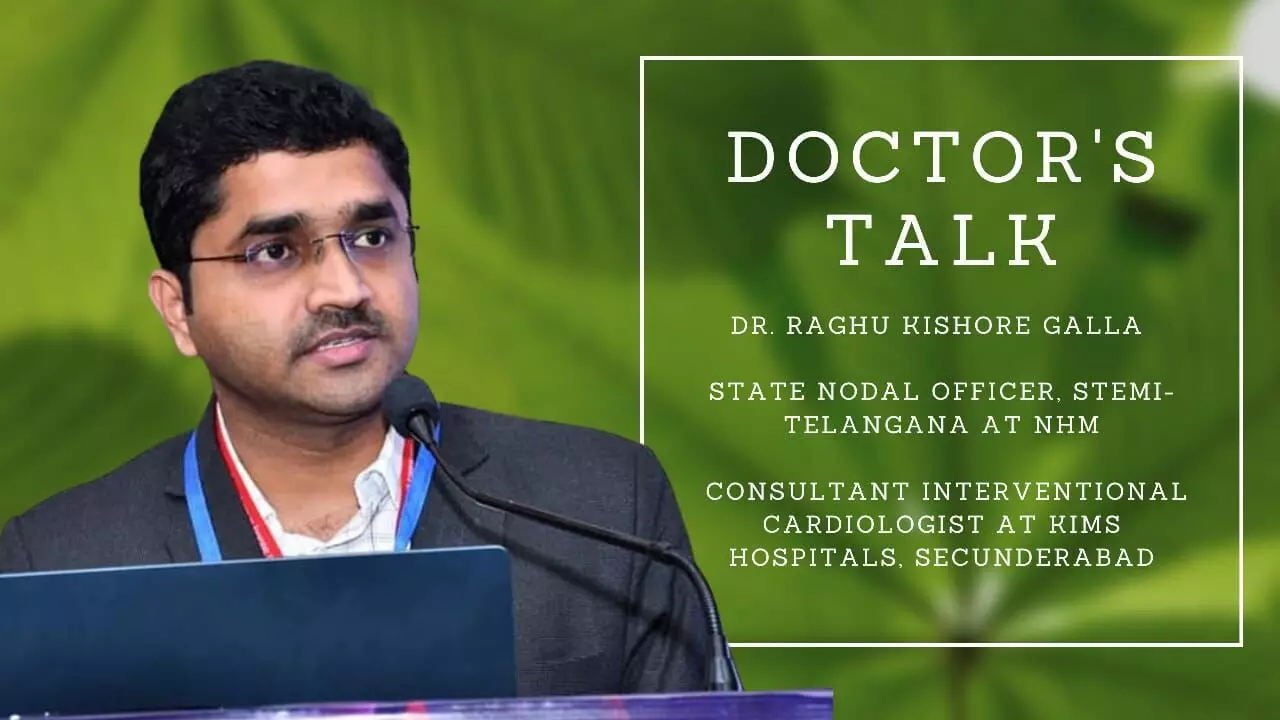Cardiologist Dr Raghu Kishore explains Telangana's STEMI model, challenges & benefits
STEMI (ST-Elevation Myocardial Infarction) is the most dangerous kind of heart attack due to 100% blockage of the coronary artery. If not identified and treated swiftly to restore blood flow in the blocked artery, it has a 50% chance of death within the next 24 hours.
By Sumavarsha kandula
Hyderabad: Telangana is among the eight states that launched the STEMI program of the National Health Mission in 2019. The program's main aim is to recognize and facilitate early treatment of heart attacks in semi-urban and rural areas.
So, what is STEMI?
STEMI (ST-Elevation Myocardial Infarction) is the most dangerous kind of heart attack due to 100% blockage of the coronary artery. If not identified and treated swiftly to restore blood flow in the blocked artery, it has a 50% chance of death within the next 24 hours.
To tackle this time-sensitive issue, the Telangana government launched the STEMI model. "The program was first initiated in June 2019, and till now, more than 3,000 STEMI cases have been diagnosed, with more than 750 STEMI cases successfully given TLT (thrombolysis)," explained Dr. Raghu Kishore Galla, cardiologist and state nodal officer, STEMI-Telangana.
NewsMeter spoke to Dr. Raghu Kishore to learn more about the STEMI model and his role in the program's success.
Asked about how he was involved with the program, Dr. Raghu said Dr. Yogita Rana, IAS, was the one who spearheaded the STEMI task force, starting the model from scratch. "She approached me in 2019 and gave me the opportunity to be the nodal officer of the state team," he added.
Dr. Raghu said he has always been inclined to work for society and this was the best way he could do it.
He further shared, "I did my MBBS from Sidhartha College and MD from Gandhi Medical College. I was also a student leader during my college years. As president of APJUDA (Andhra Pradesh Junior Doctors Association), I pushed for and got a raise in stipend."
After post-graduation, Dr. Raghu Kishore returned to his hometown Khammam to practice as a general physician for four years.
"But I wanted to do a super specialty. I wrote the entrance exam and secured first rank in Nizam Institute of Medical Sciences. I was always interested in cardiology, so I chose this field," he added.
STEMI model explained
When asked what the STEMI model is, the doctor explained, "Primarily, it is about providing immediate treatment as quickly as possible, at the grassroots level."
Speaking about its functioning, the doctor said they follow the 'Hub and spoke' model. "The main medical facility units like Osmania, Gandhi, MGM Warangal, NIMS, and Khammam district hospital act as 'hubs,' while all the other hospitals in districts and rural areas act as 'spoke'," he explained.
Telangana has five hubs and 74 spokes as part of the STEMI program.
He further said, "When a person is suspected of having a heart attack, they will undergo the ECG (electrocardiogram) test for which equipment is available at every health care facility. Based on that, if there is ST elevation (a finding on the ECG wherein the trace in the ST segment is abnormally high above the baseline), the patient will have to undergo the treatment within six hours."
Treatment and infrastructural difficulties
Speaking about the treatment and infrastructural difficulties, the doctor said, "In this situation, the gold standard treatment is angioplasty within 90 minutes for zero damage to the heart. This process requires a cardiac surgeon and a cath lab, which are not present at the peripheries. That's when the STEMI model helps. In this, we give thrombolysis treatment to the patient, which clears the block by 50-60%, giving the patient and doctor time to treat them further at the hubs."
He added, "So the 'hubs' provide angioplasty, where cardiologists are present and 'spokes' provide immediate thrombolysis so physicians and other trained doctors can save the patient. We are planning to attach around 20 spokes to each hub."
Challenges to the model
Speaking about the challenges faced in this model, Dr. Raghu said, "One of the main issues is that doctors at the periphery care centers are sometimes not sure about reading the ECG. For this, we have an app through which the recorded ECG is transmitted to the hub in 20 seconds, where the doctors are present 24x7. Through this technology, the doctors present, including myself, will get the notification and mail so that no diagnosis is missed. We have also trained the medical staff at spokes to deal with other complications that might arise while treating the patient."
He further added, "We have done two lakh ECGs and identified 7,500 critical cases. Around 3,000 were ST elevated, and we could give thrombolysis for about 825 cases. The thrombolysis injection costs approximately Rs. 40,000, but we offer it regardless of Arogyasree within 20 minutes of the diagnosis."
Advantages of data collection
Another advantage of the STEMI program has been data collection. "Previously, heart issues were considered a rich people's condition, often associated with obesity and a sedentary lifestyle. But as the STEMI program was mainly concentrated in rural areas, data coming out shows about 42.8 % affected were daily wage workers and 31% were farmers," the doctor explained.
When asked what might be the reason, Dr. Raghu said it is not yet clear. "We'll need some time to go over the data. Screening for hypertension and diabetes, which can lead to heart attacks, is not in place, resulting in underlying heart problems. Stress and prolonged Covid can also be some factors. Chewing tobacco is also not considered a risk factor prevalent among the rural population," he said.
Asked what is the way forward, Dr. Raghu said the focus would be on prevention. "With the data that has come forward, we can even map the issues geographically and improve health facilities accordingly," he added.